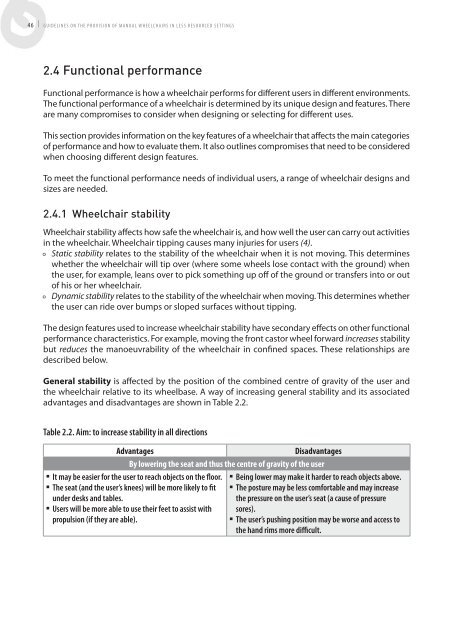Manual Wheelchairs - World Health Organization
Manual Wheelchairs - World Health Organization
Manual Wheelchairs - World Health Organization
You also want an ePaper? Increase the reach of your titles
YUMPU automatically turns print PDFs into web optimized ePapers that Google loves.
46 I guIdelInes on the provIsIon of manual wheelchaIrs In less resourced settIngs<br />
2.4 Functional performance<br />
Functional performance is how a wheelchair performs for different users in different environments.<br />
The functional performance of a wheelchair is determined by its unique design and features. There<br />
are many compromises to consider when designing or selecting for different uses.<br />
This section provides information on the key features of a wheelchair that affects the main categories<br />
of performance and how to evaluate them. It also outlines compromises that need to be considered<br />
when choosing different design features.<br />
To meet the functional performance needs of individual users, a range of wheelchair designs and<br />
sizes are needed.<br />
2.4.1 Wheelchair stability<br />
Wheelchair stability affects how safe the wheelchair is, and how well the user can carry out activities<br />
in the wheelchair. Wheelchair tipping causes many injuries for users (4).<br />
• Static stability relates to the stability of the wheelchair when it is not moving. This determines<br />
whether the wheelchair will tip over (where some wheels lose contact with the ground) when<br />
the user, for example, leans over to pick something up off of the ground or transfers into or out<br />
of his or her wheelchair.<br />
• Dynamic stability relates to the stability of the wheelchair when moving. This determines whether<br />
the user can ride over bumps or sloped surfaces without tipping.<br />
The design features used to increase wheelchair stability have secondary effects on other functional<br />
performance characteristics. For example, moving the front castor wheel forward increases stability<br />
but reduces the manoeuvrability of the wheelchair in confined spaces. These relationships are<br />
described below.<br />
General stability is affected by the position of the combined centre of gravity of the user and<br />
the wheelchair relative to its wheelbase. A way of increasing general stability and its associated<br />
advantages and disadvantages are shown in Table 2.2.<br />
Table 2.2. Aim: to increase stability in all directions<br />
Advantages Disadvantages<br />
By lowering the seat and thus the centre of gravity of the user<br />
n It may be easier for the user to reach objects on the floor.<br />
n The seat (and the user’s knees) will be more likely to fit<br />
under desks and tables.<br />
n Users will be more able to use their feet to assist with<br />
propulsion (if they are able).<br />
n Being lower may make it harder to reach objects above.<br />
n The posture may be less comfortable and may increase<br />
the pressure on the user’s seat (a cause of pressure<br />
sores).<br />
n The user’s pushing position may be worse and access to<br />
the hand rims more difficult.

















